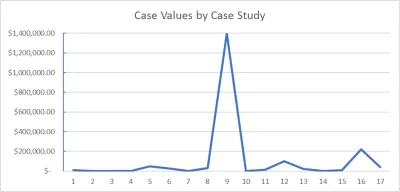Looking at a sample of 17 cases involving tinnitus in the State of Florida, we saw three high-value outliers: $100,000, $222,309, and $1.4 million dollars. These values, which are significantly different to most other cases in the sample, are outliers. To determine if a case qualified as an outlier for this sample, we analyzed each case’s trend relative to all the other cases, as well as their comparison to the average case value excluding defense verdicts and outliers, and found that most case values were $50,000 and under, leading us to conclude than any value over $50,000 was an outlier. If you look at Figure 1, you can see the outliers, which are clearly represented by the peaks of the graph, especially in Case Study 9.

Statistically, outliers are values that show as far above (or below) the calculated average of any data set. These outliers direct a researcher to look at a data point to determine why that point would stray from the regular trend of values seem in the set. In jury verdict research, outliers point anyone analyzing jury verdicts to a case to analyze the facts of that case and determine why that case received a higher verdict or settlement in a jury trial setting than another comparable case. Most importantly, high-value outliers must be studied in terms of their ability to skew the average of a data set. Because outliers often cause the average case value of a sample to change, it’s imperative to always calculate averages with and without the outliers for the most representative average of a data set.
Cases including outliers commonly have clarifying situations that warrant their deviation from the overall trend of the other cases in the sample. To exemplify this, let’s look at the outliers from the sample, starting with the highest-valued case.
In Case 9, the plaintiff, a 48-year-old female in Duval County, filed a medical malpractice suit based on Pharmacy Negligence when she went to see her primary care physician for symptoms associated with food poisoning. The defendant physician wrote a prescription for 100mg of Phenergan, also known as Promethazine, which alleviates symptoms of nausea. Prior to the prescription being filled, the defendant physician’s office allegedly notified the defendant pharmacy, Walgreen’s, to cancel the prescription because it was incorrect. The pharmacy, nevertheless, gave the prescription to the plaintiff’s husband in the amount originally written by the physician. The plaintiff took the medication and began feeling multiple symptoms culminating in tinnitus. She was taken to the emergency and released after treatment, but continued to experience tinnitus. This case was resolved by a plaintiff’s verdict and an award amount of $1.4 million dollars. The breakdown of the award was not specified.
Case Study 16 involved a 40-year-old male plaintiff in Palm Beach County who was involved in a motor vehicle accident. The defendant in this case was the plaintiff’s uninsured/underinsured motorist carrier. The defendant admitted liability in this case, but disputed the extent of the plaintiff’s injury. The plaintiff suffered post-concussion syndrome, tinnitus, and headaches after being involved in a rear-end collision with a nonparty vehicle. He claimed that the defendants issued a policy of insurance under which he was entitled to UM coverage and that they failed to uphold the policy provisions. The jury found that the plaintiff had suffered a permanent injury and found for the plaintiff. They awarded a total award of $222,309 which was comprised on $12,309 for past medical bills, $40,000 for future medical bills, $100,000 for pain and suffering, and $70,000 for lost wages.
Finally, Case Study 12 was a premises liability case involving an assault at a condominium complex on a 48-year-old female plaintiff. She suffered TMJ, tinnitus, and headaches when she was assaulted while walking from her parking space to her building at the defendant condominium complex. The plaintiff alleged that the defendant failed to provide sufficient security and that there had been prior crimes committed on the premises. The defendant complex claimed that the plaintiff’s injuries were caused by a nonparty, that additional security wouldn’t have prevented the assault, and that there hadn’t been prior crimes against a person on the premises. This case was resolved by a comparative negligence verdict with a negligence apportionment of 49% to the plaintiff and 51% to the defendant. The original award amount was $100,000 which included $5,000 for past medical bills, $25,000 for future medical bills, and $70,000 for pain and suffering; however, this award was reduced to $51,000 for comparative negligence apportionment.
To learn more about the value attributed to all tinnitus cases, please click here.
If you’re a potential client, or an attorney seeking a second opinion, and would like to discuss the value of your case please feel free to call me anytime at (850)-244-3310.






